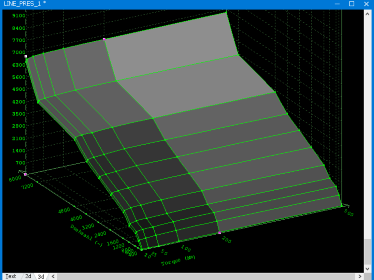It's likely more work than you think it is

The TCU (Transmission Control Unit) defines how a transmission operates and reacts to driver inputs. From a driver’s perspective, the operation looks very simple. You stomp on the throttle, and the transmission starts to upshift the gears and downshift them once you slow down the car. The complex task behind this is that the transmission information must pre-calculate constantly what the driver expects it to do next, as there is no formula to calculate technically correct shift points.
Such a thing as a correct shift point only exists if you focus on a single variable like optimal acceleration under full-throttle. In reality, this is a multi-variable situation, where many things have to be considered like uphill/downhill driving, current brake pressure, torque reserve of the engine in the current state, current steering wheel angle (cornering), current wheel-slip (e.g., ice or snow driving), unique operating modes of engine/transmission (e.g. Particulate Filter regeneration, cold-start, overheat protection mode etc.), data from the Navigation System (e.g. tight corner or incline ahead), current gradient of the throttle operation by the driver and many, many more.
In a perfect world, the TCU could gather all those inputs, sum them up, apply a formula, and spit out the ideal shift strategy. That’s what OEMs are doing to a high degree in their efforts to reduce costs. Many maps get "pre-calibrated" by the computer nowadays. Mapping starts precisely where the capacity of the computer ends, and that’s the fine line between "technically correct" and "perceived correct.“ All those "hard" data points are now layered by the engineer mapping with a particular target group in mind. The permanent question is whether the customer will deem a specific behavior in an individual situation correct. What customer A sees as proper behavior can be judged as unbearable action by customer B.
A simple example: Let's assume that for moderate acceleration on a flat surface, the transmission is programmed to upshift all gears at around 1,500 (Engine-)RPM. Technically, this would be OK for most vehicles and lead to a relaxed, high economy, low-wear driving style overall. Nevertheless, that behavior will be perceived totally differently in a 1-Series 4-cylinder compared to a 7-Series with an 8-cylinder engine. And even within the exact vehicle, certain customer groups will judge this as wrong behavior, and they will do so for various reasons. In the aftermath of this article, there will be a vital discussion on Facebook. ;) Manufacturers try to solve this by implementing multiple driving programs into the TCU, e.g., BMW with the DEC-Controller and its Eco-Pro, Comfort, Sport, and Sport+ settings, which can be combined with the 3 positions of the Gear Shift Lever (D-Mode, S-Mode, M-Mode).
Each combination of those inputs can be configured independently (more or less) and activates different maps that lead to different shift strategies, which are very different between vehicles. S/Sport+ in an M135i will behave differently, as in a 550i, and will again be different in an X5 M50d. It's all about the specific vehicle and the target group driving with it. To give another easy example: Some cars can shift directly from 8th to 2nd Gear when the driver mashes the throttle, while others don’t. The transmission can always do it, but for some models, the OEM decided not to allow such a massive jump in gears, as the planned target group could see it as unfavorable.
Everything above only refers to the most apparent part of transmission control: The shift points when a transmission switches from one gear to another. Other control areas are the clutch pressures inside and outside of shifts, the clutch-timing on shifts (which significantly influences the shift comfort), the slip of the Torque Converter Clutch, clutch-stress calculations, traction management during Launch Control, etc. Overall, a modern transmission controller sports around 15.000 maps. Many are only there to alter the behavior in specific situations, e.g., Towing. For instance, a customer living in a flat area and never driving in the mountains won't touch thousands of those maps. They want to come into play until there’s an incline.
With the above said, it should clarify what "mapping a transmission" means and why a single calibration can't be used for all cars. Regarding xHP, a Stage 3 file is mapped precisely for a particular vehicle. There is no relation between Stage 3 on a 330d and Stage 3 on a 330i. In some cases, not even a M135i and a 335i can share the same setup. (for instance, if different base programs are used by the OEM) This is why we sometimes can't release support for some vehicles, although they look very similar to already supported ones from a customer’s perspective.
Our customers (in most cases) are searching for a more sportive behavior of their transmission, and that’s what we have in mind when doing the Maps. We remove compromises the OEM had to make for various reasons (for instance, to keep distance to the next higher model), we rethink the logic of calibrations from scratch sometimes, and we do our development on the street. This is a job that can’t be done on a Dyno. While the OEM has to consider a broad range of target groups for each vehicle, we can sharpen things as xHP customers can switch between 3 Stages and alter things like the Shift-Points to their personal liking with the built-in Editor. For a Stage 3 map, the main goal is always to deliver more raw performance, but this is only a tiny part of mapping. Way more time is necessary to redefine the overall behavior during street driving so that it leads to more fun with your car daily! Not only on the Racetrack but also on the way there.
